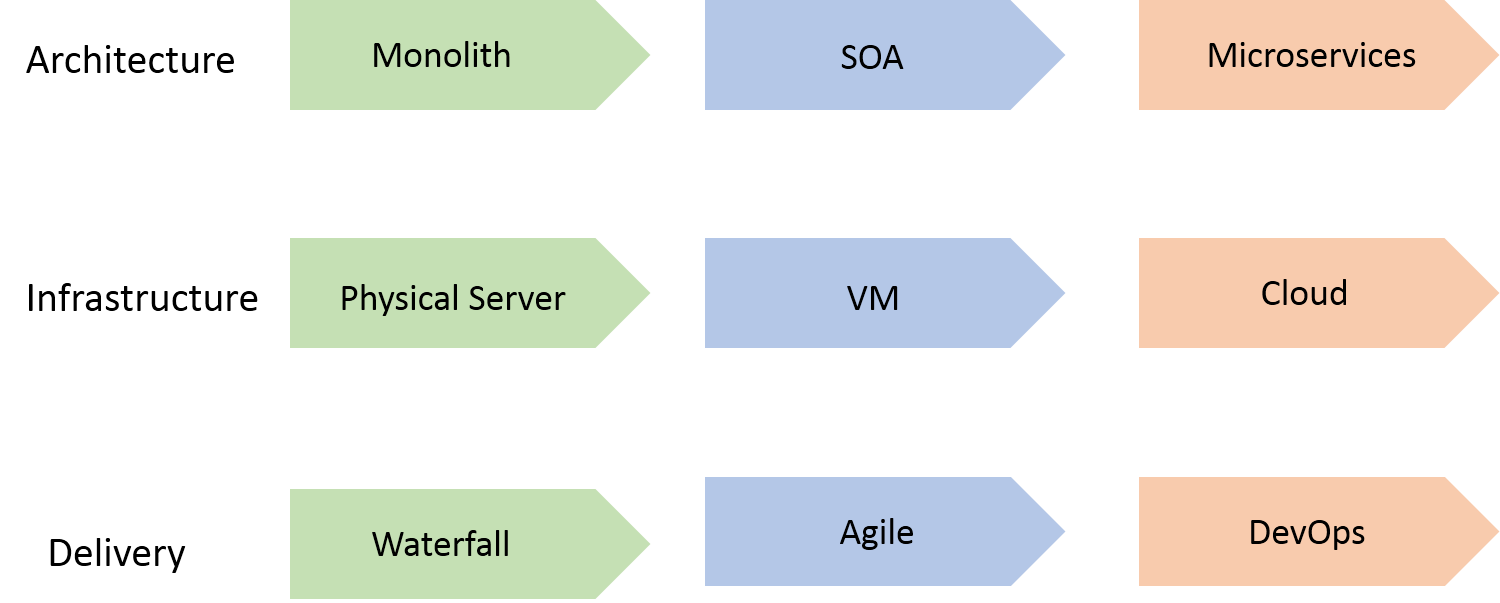
When legacy systems hold back the business growth, IT teams race to modernize the existing solutions, thereby creating new business value out of them. The process involves technical or functional improvements, which may range anywhere between rewriting code, migration to a different platform, changing the architecture, or even replacing the entire system with a newer one.
There are seven different approaches to legacy software modernization that helps businesses to derive value from legacy systems. Nevertheless, no matter what approach is followed to modernize a solution, the best thing that can be done to develop a new, scalable solution is to build a strong foundation, i.e. the architecture, infrastructure, and delivery cycle.
All three components are silent performers in building an efficient, scalable product with minimum time-to-market. Working on them ensures that the by-product of modernization is promising for a longer run.
The later segment discusses the importance of transforming the architecture, infrastructure, and delivery for an impactful modernization.

Software architecture defines how the components of a software system should be assembled/organized (architectural pattern), how they communicate with each other (system integration), and what are the constraints that the whole system is ruled by (quality attributes).
Depending upon how scalable/adaptable an application is, how dependent or independent the components are, and how the components interact, software architectures can be defined and designed for a software solution. This job is performed by a software architect.
A software architect is like an airline pilot, he might not look busy all of the time but he uses decades of experience to constantly monitor the situation, taking immediate action if he sees or hears something out of the ordinary. So basically, an architect is responsible for laying down the basis for the application, creating a rough sketch of how the application and its components will behave.
ALSO READ: The Importance of Choosing a Good Software Architecture
As software development becomes complex and scalable, it is critical to build software with an architecture that keeps the functions and services independent of each other. That is why the software development industry evolved from monolith to SOA and microservices architecture. While monolithic architecture is a unified model for designing software, service-oriented architecture (SOA) and microservices are modular approaches to design software.
For building scalable, fault-isolated software that’s continuously developed and deployed, it is recommended to modernize applications with microservices architecture. Updating architecture should be the foremost step when modernizing a software architecture as architecture is where the development starts from.
2. Modernizing the Infrastructure
These days, it is extremely crucial to automate the infrastructure as applications can be deployed to the production server, multiple times in a day. Since infrastructure services consume a large part of IT budgets, optimizing the infrastructure for performance, cost, and efficiency is important.
Moving the existing infrastructure from physical servers to the cloud is one of the most sought after approaches to optimize the infrastructure. Different tools, technologies, and services contribute to making an application scalable, highly available, and manageable.
On-premise to cloud migration is one of the sought after approaches when it comes to managing infrastructure. Amongst the innumerable benefits that cloud offers, the one that favors the modern software applications is auto-management of servers and their auto-scaling. By opting for options such as serverless computing, the IT infra teams can be freed up from resource management tasks as the application scales-up or scales down. Along with resource management, going serverless help in optimizing cost (CapEx, OpEx), improve performance, and ensures high availability.
When modernizing an application, optimizing infrastructure to cloud is a must-have. Along with the countless advantages that cloud offers, like scalability, auto-resource management, it offers the benefit of disaster recovery with ease, which is otherwise a tedious effort when done with physical infrastructure.
ALSO READ: The Ultimate Guide to Infrastructure Optimization on Cloud
3. Modernizing the Delivery Cycle
Application development is an on-going process. Even when an application is deployed to production, the process of its maintenance and updation continuous. To make sure that the entire cycle of moving an application from test to the production environment is seamless, it is important to pay attention to the delivery cycle.
While Agile practices emphasize flexibility, continuous improvement, and collaboration to building a scalable software application, it needs a complementary approach to make the delivery cycle smooth. Today, when we have multiple updates to be deployed in a day, automating the delivery pipeline becomes critical.
To accompany Agile, the DevOps culture came into existence which ensures that an application is built, tested, and released faster. Moreover, involving DevOps to the software development cycle means automation of processes such as integration, delivery, monitoring, testing, and more.
When modernizing the application with infrastructure and architecture, it is important to update the delivery approach for software development as well. Also, when the three core strengths of application modernization discussed above complement each other and are dependent on one other.
Planning to Modernize your Legacy Application?
Implementing a new architecture, infrastructure, and delivery cycle takes a lot of effort, time, and technical expertise. Modernizing applications without hampering the base and user data is what’s needed to bring a value-adding solution for the business.
At Daffodil, we have an experienced team for custom software development that keeps every crucial factor into consideration while developing a solution for your business. To understand which modernization approach will work best for your business, set up a free consultation session where our team will understand your business, the shortcomings of your existing system, and suggest a viable solution.



